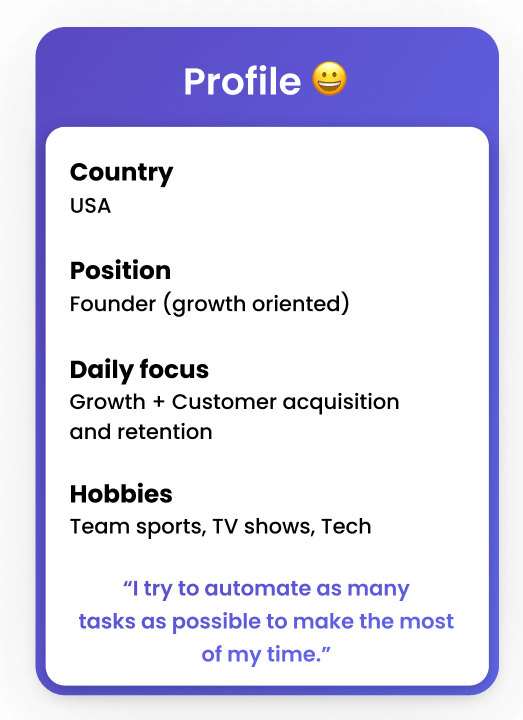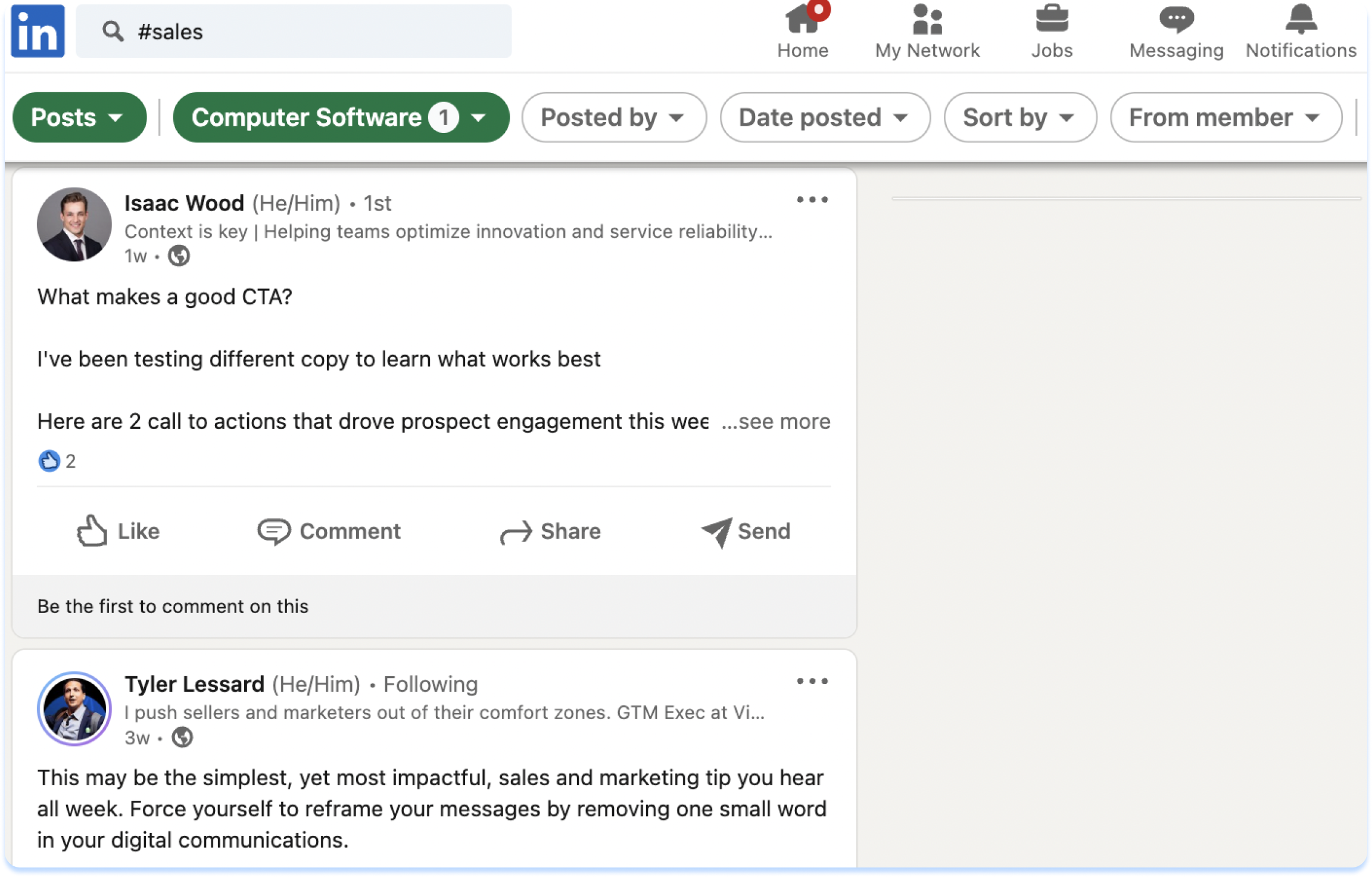How to define your B2B audience (+ buyer persona template)

How do you know that you're reaching out to the wrong audience?
Well, if you caught yourself:
- Stuck on the outreach personalization
- On a meeting with unqualified leads
- Putting too much effort into deals that end up too small
…then you should review who you're sending your emails to.
Targeting the wrong people results in low reply and conversion rates and slows down your sales.
By defining your precise audience you can:
- Craft better personalization
- Increase your credibility
- Get a higher reply rate
So, keep reading as we share the audience research process and buyer persona template that got us from 0 to 20k+ customers.
1. At the company level: Identify your ICP
ICP is a hypothetical description of the type of company that would realize the most value from your product or service.
Why do you need it?
Well, the more value you give to your customers, the more value you receive back. Helping businesses gain profit will keep them loyal and make you more profit.
We’ll leave you this video and our free buyer persona generator to learn how to identify your ICP ⬇️
Make sure to focus on the right ones by following this ICP process:
A. Make a list of your best clients
Check out the list of your current clients and see which ones:
- Bring you the most profit
- Gain the most value from you
- Have been the longest with you
Why? Because if they are your best customers, it’s natural you want more of them!
In case you don’t have any clients yet, the key is in networking.
Make a list of potential clients, reach out to them on LinkedIn, and verify:
- The struggles they might be facing
- Who is the end-user and who is the decision-maker
- If it makes sense for them to proceed with a solution like yours
And once you’ve identified the best (potential) clients, it’s time to…
B. Research their attributes
Gather basic information about the company such as:
- Industry
- Size (number of customers and employees)
- Revenue
- Location (are they local, regional, national, or international)
- Growth rate
- Tech stack (to analyze the company’s specific web technologies, try BuiltWith lookup)
- LTV (lifetime value)
You can even go further by checking out their social and cultural characteristics such as:
- What is their company culture?
- What are their values?
- Their ways of working?
Use this information as an icebreaker that will make you stand out and build rapport more easily.
Then, look at some recent changes that may have occurred in the company such as:
- Structural changes
- Hiring new people
- Company merger or acquisition
These changes can have an impact on their needs. For example, if they are growing fast, they’ll be more likely to invest in new tools.
The last thing you can do is call them or conduct interviews.
Knowing answers to these questions will help you absolutely crush your personalization which will ensure a high reply rate:
- What are their goals for the next X months, X years?
- What are their biggest pain points/challenges?
- What impact does the specific problem have on their team/company?
- What problem is your product solving for them?
- Are they satisfied with your product?
- What are the most important features for them?
- What’s their buying process like?
- How much do they have to allocate to products like yours?
Once you’ve collected all this information, the next thing to do is to…
C. Identify the common attributes
See the patterns between your best clients that are recurring from one account to another. Once you identify similarities, it means you’re on the right path!
Why? Those attributes are the ones you want to search for in your new customers, ensuring they will become your next best clients as well.
Now that you’ve determined the companies you want to work with, it’s time to think about the actual person working there that you want to reach out to, AKA your buyer persona.
You can also complete this process using AI!
2. At the people level: Establish your buyer persona
A buyer persona is a detailed description of someone who represents your target audience.
Even though it’s fictional, it’s based on deep research and can help you boost outreach personalization.
Simply download this free buyer persona template we created for you, and follow these steps:
Give life to your persona
First, you want to start by adding a profile picture to your persona.
You can use copyright-free avatar libraries such as Pexels, Unsplash, and Pixabay.
If you don’t want to use a photo of other people, try This Person Does Not Exist as it generates realistic photos of people who don’t exist.
Then, think about their name and write down their position.
All of this should give you the sense you’re talking to a real person, and not a company:

Then, you can start digging into the details a little bit more in their…
Profile section
The first thing you want to focus on here is their professional background.
If you know the roles you want to reach out to, you can find out more about those people by running a simple LinkedIn search with a job title filter:

The search results will be the profiles that are likely to look for a tool like yours and the ones you should target with your cold outreach.
You can go the extra mile by checking out community groups on Facebook and LinkedIn.
They are usually a place for like-minded people who share and discuss similar interests and search for solutions you might provide.
The next thing you want to look up is their demographics, such as age, location, or gender.
The truth is, you won’t talk the same way to Gen Z persona or boomer, right?
A good platform that can give you these answers is Google Analytics. If your website content matches your business intent, 80% of the visitors should have characteristics of your target audience.

If you're just starting out and don’t have enough traffic yet, you can use SparkToro audience research or sales databases like UpLead or LeadFuze.
The last thing you want to check out is your prospect’s interests.
They will help you create meaningful content and find a common ground to break the ice.
Here, again, Google Analytics can help:

The other way is to scroll through their social media accounts where you can find out their interests outside of work and what their typical day looks like. Check out where they live, and how tech-savvy they are, and think about the quote that describes them well.
Here’s what the Profile section looks like for our buyer persona:

Once you have set your persona’s basic info, it’s time to hop on to their…
Goals and Objectives
Once you understand the exact goals of your target, you’ll be able to offer them a unique value that makes them more likely to reply.
How?
Instead of talking about features, you can talk about how they can achieve their goals with your product.
Keep in mind that objectives aren't the same as goals. Objectives are specific and measurable, whereas goals will be more general.
Here are a few ways you can find out more about your persona’s goals and objectives:
- Search your industry’s keyword on LinkedIn and see what’s discussed in posts:

- Read through customer reviews:

- Check out Facebook and LinkedIn community questions:

- Look at prospect’s job posts as they often outline their goals and the direction in which the company is planning to go:

In the end, your section should look like this:

In lemlist we live to make your outreach easier, so we bring a new function that will help you automate this process and let AI build your ideal customer profile. Learn how.

Now, it’s time to investigate…
How did they hear about you?
Knowing how your prospect found out about you will help you create actionable content and distribute it more efficiently.
Once you know the content, social media channel, or outbound method they prefer, you can reach out to them where they are which will make them more likely to reply.
Here’s an example of where a lemlist buyer persona discovers our brand:

Once you gather this info, you can examine further their…
Path to purchase
To round up your persona’s path to conversion, you can use these information sources:
- Website tracking
- Outreach campaigns funnels
- Their engagement in relevant communities
In the end, you’ll end up with a step-by-step process like this:

The only thing left to cover is…
What could hold them back?
Knowing what could hold back your target to convert is one of the key findings.
Why? Because you can come prepared to handle any objections.
For example, if someone tells you that your product is too expensive, you can talk about the ROI or the value it delivers to the business which is much bigger than the initial price.
Here are a few of our examples to help you out:

3. Segment buyer persona into tiers
The last step of defining your B2B target audience is separating buyer persona into tiers.
This step is vital because it allows you to identify which targets will be the most profitable, and where you should be spending most of your time.
You can identify them into three tiers, based on the amount of value you are bringing to them, which will later translate to the amount of revenue they are bringing to you.
Your tier 1 will be your accounts generating the most revenue, your tier 2 clients are the ones in between, and tier 3 is bringing in the least revenue.

You can use these tiers as indicators of where to put the most effort when it comes to personalization and lead generation.
To learn how to automate ICP and buyer persona processes with AI, use these 3 steps to defining your target audience with AI.
Key takeaways
To sum up, the goal of defining a buyer persona is to clearly understand what your audience's challenges are so you can offer them the right solution.
Once you have a solution to their specific pain point, it’s much easier to build a relationship, and eventually, sell your product or service.
Remember that your ideal buyer persona should be the one that helps you:
- Bring more revenue
- Shorten sales cycle
- Close bigger deals
Once you have yours, use it to:
- Personalize your cold outreach to get more replies and build meaningful relationships
- Introduce it to the rest of your company so they get a clear perception of who they’re talking to
- Integrate it into your product planning and user experience
And don’t forget - If you try to reach everybody, you’ll reach nobody!
Each persona will require a different and tailored approach.
To automate your cold outreach personalization, check out this email personalization tool and open new business opportunities. 🚀
P.S. If you liked what you read and would like to download it as a PDF or share it with your friends, we’ve prepared this free, step-by-step eBook that will help you:
✓ define the companies you want to target (your Ideal Customer Profile)
✓ define the people you want to get in touch with (your buyer persona)
✓ segment buyer personas into tiers for best outreach results 🔥



















booster lemwarm for free




























More than 10 users?



















booster lemwarm for free




























More than 10 users?



















booster lemwarm for free

































%20(1)%20copy%20Cropped.jpg)







.png)






